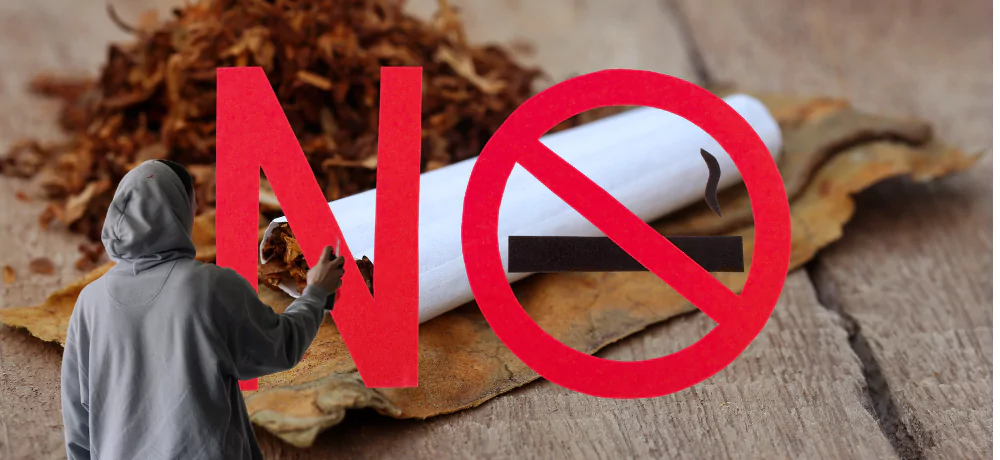
How Do We Need to Stop Tobacco from Targeting Youth?This percentage is quite worrying because nicotine can harm a teenager’s brain development and cause long-term health problems. To protect the next generation youth, we must understand the situation and know how to tackle the situation tactfully and stop tobacco from targeting youth.
The tobacco industry always focuses on attracting young individuals. This grows as a serious public health concern which needs immediate attention. Despite increasing awareness about the dangers of tobacco, the tobacco product manufacturing companies still use clear yet attractive marketing to hook the teenagers.
According to a recent survey report, around 20% of high school students are using e-cigarettes, often driven by their appealing flavors and misleading advertisements.
Let’s read this blog carefully and work towards giving the youth a healthier, smoke-free future.
What is the Alarming Statistics of Youth Individuals Consuming Tobacco?
According to the World Health Organization Report, nearly 90% of smokers start using cigarette smoking and tobacco products before the age of 18.
In 2019, India’s Global Youth Tobacco Survey reveals that 8.4% of school-going children aged 13-15 years currently use tobacco. By the age of seven, 11.4% of children have already smoked cigarettes, 17.2% have started smoking bidis. Even the most shocking truth is that 24% of young people have begun using smokeless tobacco products like gutkha, khaini.
The Centres for Disease Control and Prevention (CDC) states that tobacco use is one of the leading causes of preventable death, killing more than 4,80,000 people every year. This number is very shocking and highlights the immense harm that tobacco use can cause.
Predatory Marketing Tactics of Tobacco Companies
The tobacco industry has used several tactics to attract young individuals. Recent report reveals that these companies employ sophisticated marketing strategies that are specifically appealing to the youth. Here are some of the most common marketing schemes:
Flavored Products:
According to the WHO survey, the tobacco industry uses candy and fruit-flavored cigarettes and vapes to entice young individuals. These marketing strategies are not just manipulative but highly effective in attracting young people into a lifetime of addiction.
Social Media Marketing:
The tobacco industry has a strong presence on social media. They are using influencers, contests, and targeted advertising to reach the youth.
Misleading Health Claims:
The tobacco product manufacturing company has a long history of making false claims about the safety of their products.
These tactics are designed to minimize the risks of tobacco use and make it seem more appealing to young people. They are, in essence, exploiting a vulnerable population.
The Dangers of Early Tobacco Use
Starting to use tobacco at a young age has severe long-lasting consequences. The adolescent brain is still developing, making it highly susceptible to addiction. Nicotine, the addictive substance in tobacco, can interfere with brain development, affecting learning, memory, and attention.
Studies have shown that young smokers are more likely to become heavy smokers later in life. According to the World Health Organization, nearly 90% of adult smokers start before the age of 18. This early initiation increases the risk of developing tobacco-related diseases, such as lung cancer, heart disease, and stroke.
Moreover, young smokers are more prone to addiction and find it more difficult to quit compared to adult smokers. The earlier the start, the harder it becomes to break free from this deadly habit. The use of tobacco products can lead to immediate health issues such as reduced lung function and respiratory problems.
A recent report from the International Respiratory Societies states the dangers of tobacco products and the need for stricter regulations to stop tobacco to protect young people from these harmful substances.
The Need for Action
Addressing the issue to stop tobacco targeting youth requires a comprehensive strategy involving multiple actions:
Implementing Strict Policies:
- Enforce regulations to limit the marketing of tobacco products to young people.
- This includes controlling advertising methods, banning youth-oriented packaging, and restricting sales practices to prevent easy access.
Enhancing Educational Programs:
- Develop and expand educational initiatives to increase awareness about the risks associated with tobacco and stop tobacco usage.
- Focus on informing youth about the misleading tactics used by the tobacco industry to attract them.
Strengthening Public Health Campaigns to Stop Tobacco:
- Launch and support public health campaigns aimed at exposing the dangers of tobacco and vaping.
- Highlight the health risks of nicotine addiction and the benefits of remaining smoke-free and avail nicotine free treatment.
Counteracting Industry Tactics:
- Use stop tobacco campaigns to directly address and counteract the deceptive marketing strategies employed by tobacco companies.
- Promote evidence-based information about the risks of vaping and smoking to discourage initiation among young people.
By combining regulatory measures, educational efforts, and public health campaigns, we can effectively combat the tobacco industry’s influence and protect youth from the dangers of tobacco and nicotine addiction.
Final Thoughts
The targeting of youth by the tobacco industry is a serious public health issue that demands urgent attention. With sophisticated marketing strategies and the introduction of new tobacco products, the industry continues to lure young people into a cycle of addiction and health problems. It is imperative that we implement robust policies and educational programs to protect our youth and break the cycle of tobacco addiction.
So, by addressing this issue head-on, we can safeguard future generations from the harms of tobacco and promote a healthier, smoke-free world.
This percentage is quite worrying because nicotine can harm a teenager’s brain development and cause long-term health problems. To protect the next generation youth, we must understand the situation and know how to tackle the situation tactfully and stop tobacco from targeting youth.
The tobacco industry always focuses on attracting young individuals. This grows as a serious public health concern which needs immediate attention. Despite increasing awareness about the dangers of tobacco, the tobacco product manufacturing companies still use clear yet attractive marketing to hook the teenagers.
According to a recent survey report, around 20% of high school students are using e-cigarettes, often driven by their appealing flavors and misleading advertisements.
Let’s read this blog carefully and work towards giving the youth a healthier, smoke-free future.
What is the Alarming Statistics of Youth Individuals Consuming Tobacco?
According to the World Health Organization Report, nearly 90% of smokers start using cigarette smoking and tobacco products before the age of 18.
In 2019, India’s Global Youth Tobacco Survey reveals that 8.4% of school-going children aged 13-15 years currently use tobacco. By the age of seven, 11.4% of children have already smoked cigarettes, 17.2% have started smoking bidis. Even the most shocking truth is that 24% of young people have begun using smokeless tobacco products like gutkha, khaini.
The Centres for Disease Control and Prevention (CDC) states that tobacco use is one of the leading causes of preventable death, killing more than 4,80,000 people every year. This number is very shocking and highlights the immense harm that tobacco use can cause.
Predatory Marketing Tactics of Tobacco Companies
The tobacco industry has used several tactics to attract young individuals. Recent report reveals that these companies employ sophisticated marketing strategies that are specifically appealing to the youth. Here are some of the most common marketing schemes:
Flavored Products:
According to the WHO survey, the tobacco industry uses candy and fruit-flavored cigarettes and vapes to entice young individuals. These marketing strategies are not just manipulative but highly effective in attracting young people into a lifetime of addiction.
Social Media Marketing:
The tobacco industry has a strong presence on social media. They are using influencers, contests, and targeted advertising to reach the youth.
Misleading Health Claims:
The tobacco product manufacturing company has a long history of making false claims about the safety of their products.
These tactics are designed to minimize the risks of tobacco use and make it seem more appealing to young people. They are, in essence, exploiting a vulnerable population.
The Dangers of Early Tobacco Use
Starting to use tobacco at a young age has severe long-lasting consequences. The adolescent brain is still developing, making it highly susceptible to addiction. Nicotine, the addictive substance in tobacco, can interfere with brain development, affecting learning, memory, and attention.
Studies have shown that young smokers are more likely to become heavy smokers later in life. According to the World Health Organization, nearly 90% of adult smokers start before the age of 18. This early initiation increases the risk of developing tobacco-related diseases, such as lung cancer, heart disease, and stroke.
Moreover, young smokers are more prone to addiction and find it more difficult to quit compared to adult smokers. The earlier the start, the harder it becomes to break free from this deadly habit. The use of tobacco products can lead to immediate health issues such as reduced lung function and respiratory problems.
A recent report from the International Respiratory Societies states the dangers of tobacco products and the need for stricter regulations to stop tobacco to protect young people from these harmful substances.
The Need for Action
Addressing the issue to stop tobacco targeting youth requires a comprehensive strategy involving multiple actions:
Implementing Strict Policies:
- Enforce regulations to limit the marketing of tobacco products to young people.
- This includes controlling advertising methods, banning youth-oriented packaging, and restricting sales practices to prevent easy access.
Enhancing Educational Programs:
- Develop and expand educational initiatives to increase awareness about the risks associated with tobacco and stop tobacco usage.
- Focus on informing youth about the misleading tactics used by the tobacco industry to attract them.
Strengthening Public Health Campaigns to Stop Tobacco:
- Launch and support public health campaigns aimed at exposing the dangers of tobacco and vaping.
- Highlight the health risks of nicotine addiction and the benefits of remaining smoke-free and avail nicotine free treatment.
Counteracting Industry Tactics:
- Use stop tobacco campaigns to directly address and counteract the deceptive marketing strategies employed by tobacco companies.
- Promote evidence-based information about the risks of vaping and smoking to discourage initiation among young people.
By combining regulatory measures, educational efforts, and public health campaigns, we can effectively combat the tobacco industry’s influence and protect youth from the dangers of tobacco and nicotine addiction.
Final Thoughts
The targeting of youth by the tobacco industry is a serious public health issue that demands urgent attention. With sophisticated marketing strategies and the introduction of new tobacco products, the industry continues to lure young people into a cycle of addiction and health problems. It is imperative that we implement robust policies and educational programs to protect our youth and break the cycle of tobacco addiction.
So, by addressing this issue head-on, we can safeguard future generations from the harms of tobacco and promote a healthier, smoke-free world.
